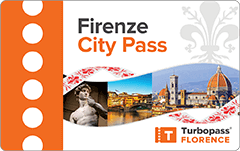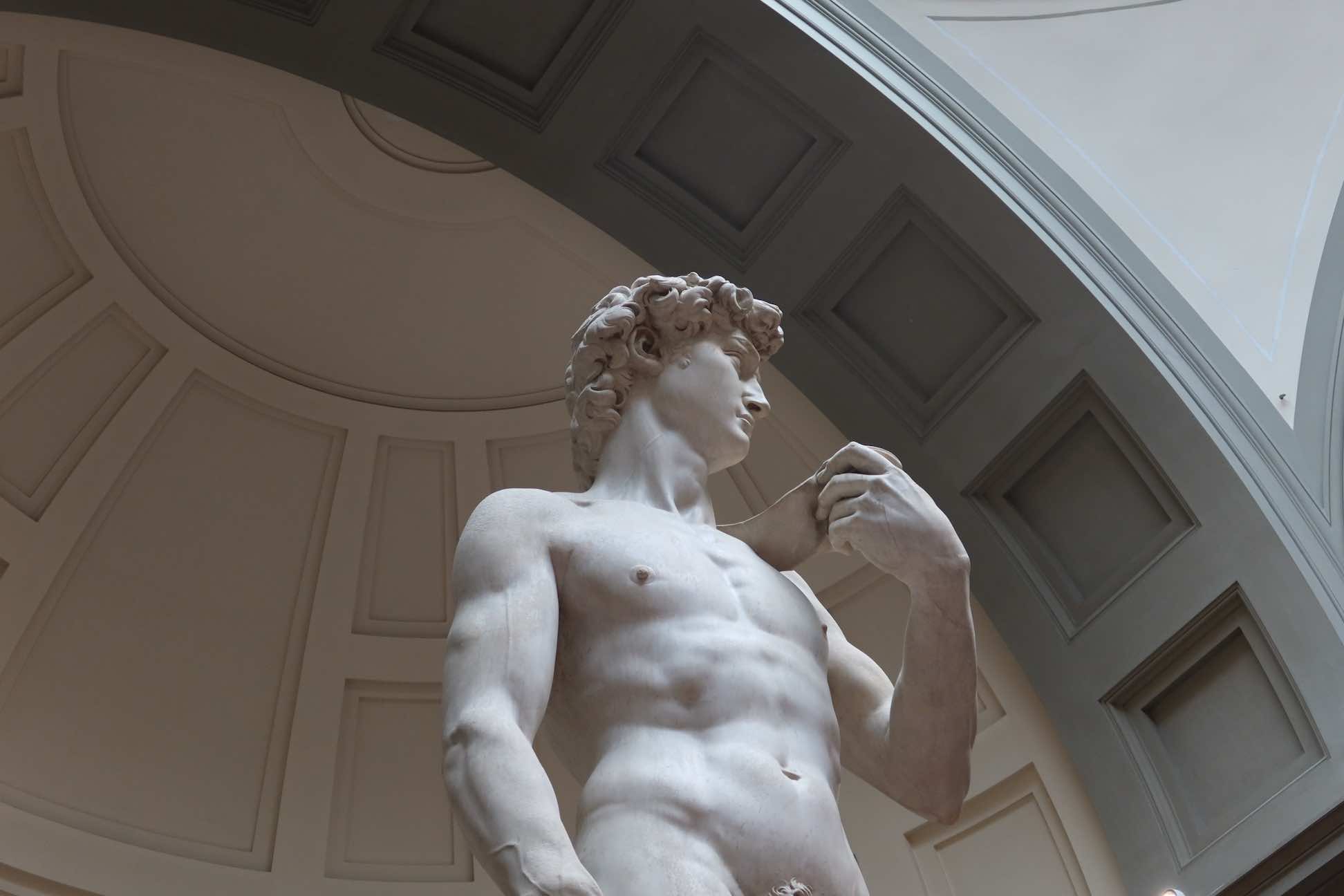- Sign up & get a FREE ebook Subscribe Today!
- Florencewise Home Page
- What to do in florence
- florence baptistery
How to Visit the Florence Baptistery
The Florence Baptistery is one of the many iconic gems in the Tuscan capital.
An architectural marvel, it is named after the city's patron saint, San Giovanni Battista (St John the Baptist).
Situated right in front of the Cathedral of Santa Maria del Fiore, the baptistery predates the church and has served as the city's baptistery since 1128, making it the oldest building in Piazza del Duomo.
The square on the east side of the Baptistery is also named after the city's patron saint: Piazza San Giovanni.
The Florence Baptistery - Everything You Need to Know
The Florence Baptistery is a captivating destination that you won't want to miss.
This stunning building holds immense historical and artistic significance.
Prepare to immerse yourself in the intricate geometrical patterns found in the colored marble, as well as the golden mosaics that beautifully depict biblical stories, fascinating symbolism, and centuries of history.
Notably, there are magnificent bronze doors, including the renowned "Gates of Paradise," adorned with intricate religious carvings showcasing impressive craftsmanship.
In the following pages, we will find out what lies behind the Florence Baptistry doors.
We will delve into the rich history and artistic heritage that make the Florence Baptistery an essential stop for those seeking to experience the cultural depth of Florence.
On this page we'll go over:
- The history of the Florence Baptistery
- The internal features of the Baptistery
- The Baptistery's external decorations
- How to visit the Florence Baptistery
The history of the Florence Baptistery
Construction of the Florence Baptistery began in the 12th century, drawing inspiration from older baptismal structures in Rome and Ravenna.
The octagonal shape, apart from practical considerations and historical traditions, holds profound Biblical symbolism.
The number eight carries special significance in Christianity.
In the Bible, it symbolizes new beginnings, notably within the creation narrative, where it signifies the start of a fresh cycle after God's rest on the seventh day.
Furthermore, eight symbolizes resurrection, as Jesus' rising on the "eighth day" signifies victory over death and spiritual rebirth.
'My beautiful Saint John'
The legendary poet Dante held the baptistery in high regard, referring to it as "My beautiful San Giovanni."
The religious building is not only architecturally intriguing but also provides a window into Florence's rich heritage.
Until 1935, all Florentines were baptized here, leading to an extensive list of prominent individuals who received this sacrament.
This list includes notable figures such as Dante himself, Amerigo Vespucci, and many notable members of the De' Medici family.
 This font was the only one in Florence until very recently, it's amazing to think of all the people who were brought here to be baptized
This font was the only one in Florence until very recently, it's amazing to think of all the people who were brought here to be baptizedProminent artists like Cimabue, Lorenzo Ghiberti, Andrea Pisano, Andrea del Verrocchio, and Donatello have contributed to the sculptures and mosaics that adorn the baptistery's green and white marble structure.
Eight for eternity
Baptism is intricately linked to the number eight, symbolizing spiritual renewal and initiation into Christianity, often represented by the octagonal shape of baptismal fonts.
Some interpretations also associate the number eight with eternity, reflecting God's infinite nature, and it signifies a new creation, akin to God's perfect creation after seven days.
The Baptistery was consecrated in 1059 by the Florentine Pope Nicholas II.
The construction was finished (partially with marble from the concerned city of Fiesole, rumour has it) in 1128.
Additions and alterations
In subsequent years, significant additions were made to the Baptistery's structure.
In 1150, an octagonal lantern was added to the roof, and in 1202, a rectangular porch was incorporated at the Western entrance.
When the Eastern entrance was opened, this porch was transformed into an apse.
The Baptistery is constructed with exquisite materials, including white Carrara marble, green Prato marble, grey sandstone for the floors and lower parts of the walls, and red porphyry.
The construction of the Baptistery extended into the Renaissance period, known for its remarkable art.
Numerous important baptisms took place here, and its close connection to the nearby Cathedral and Bell Tower underscores its significance in Florence's history.
Renowned for its exceptional artistry, the Baptistery, dedicated to St John the Baptist, is particularly famous for its extraordinary bronze doors.
Interestingly, there was a competition to create the baptistery's northern doors. Ghiberti's design was chosen over a design by the famous Filippo Brunelleschi, who would later design the famous dome of the Santa Maria del Fiore cathedral.
Ghiberti's baptistery door, linking scenes from the Old Testament to the New and created out of bronze casting would get its name "Gates of Paradise" from none other than Michelangelo himself.
The internal features of the Baptistery
The interior of the Baptistery of San Giovanni is indeed remarkable, with a stunning mosaic floor that features an intricate geometric pattern covering over a thousand square meters.
The mosaics on the ceiling are even more magnificent.
The ceiling's artwork began in the 13th century, led by Byzantine masters of mosaic art.
Over time, this stunning ceiling was further enriched by contributions from renowned artists like Cimabue.
Among the vivid biblical scenes depicted, the Last Judgment stands out, with Christ the Judge presiding over the sacred space, imbuing it with profound spiritual significance.
As time passed, subsequent generations of Florentine artists continued this ambitious project, and the furnaces were modernized to produce more luxurious mosaics.
This transformation introduced a vibrant spectrum of colors, including copper-green and brown majolica, as well as the exquisite and costly "saffron" tesserae, which incorporated cobalt blue alongside the traditional hues.
Within the Baptistery, the cupola unveils a rich mosaic tapestry.
Initiated in the 13th century by the Franciscan friar Jacopo, it saw contributions from esteemed artists such as Cimabue and Coppo di Marcovaldo.
Nestled within the Baptistery's interior, you'll also discover the tomb of Anti pope John XXIII from the 1400's, adding a unique historical dimension to this sacred space.
 The anti pope had close connections to Florence and was rewarded with a tomb in this very special location
The anti pope had close connections to Florence and was rewarded with a tomb in this very special locationTake a look at these pages to find out how to make the most of your time in Florence:
Maintenance problems
The first damage to the mosaics was caused by water infiltration and have been documented since the mid-14th century.
Over the years, various maintenance interventions have been undertaken in an attempt to address this issue.
 There are often restorations ongoing, but you can still visit and see the elements not being worked on
There are often restorations ongoing, but you can still visit and see the elements not being worked onDespite the continuous attention to the problem, a small portion of this precious artwork was unfortunately lost.
In the year 1819, a tragedy occurred when the cycle known as the "Stories of Noah" fell from the ceiling, and the damage proved to be irreparable.
No matter what season you visit Florence, here are 4 things never to leave at home:
Disclosure: If you make a purchase through a link on this page, I may receive a small commission - at no extra cost to you. Thank you for supporting my site!
The Baptistery's external decorations
The Baptistery of Florence, a true marvel for any visitor, is renowned for its striking green and white geometrically patterned colored marble exterior adorned with intricate statues and details.
The octagonal building boasts a unique pyramid-shaped roof.
 The green and white marble pattern inspired the design of the nearby cathedral and bell tower, being built first
The green and white marble pattern inspired the design of the nearby cathedral and bell tower, being built firstAdorned with ornate statues, showcasing intricate Gothic and Romanesque architectural details, the Baptistery is a visual feast.
The outer doors are not just mere entrances but masterpieces of art and history that narrate the tales of saints, biblical scenes, and renowned sculptors.
Each door has its own story to tell, and together, they invite you on a journey through time and faith.
Let's step closer and explore the enchanting narratives etched into the South, North, and East doors of this iconic baptistery.
Want to see the Baptistery doors up close for yourself?
Join this small group walking tour of Florence which gets you up close with the Baptistery before heading inside the Duomo, and then around other top sights.
The Gates of Paradise - The East Doors
As you approach the awe-inspiring Florence Baptistery, your eyes are inevitably drawn to a trio of magnificent gilded bronze doors.
The most famous set are known as the Gates of Paradise, and were a revelation when they were originally completed.
Standing right in front of the Duomo, the East doors crafted by Ghiberti, are arguably the most famous of the three sets.
The doors consist of golden panels depicting scenes from the Old Testament, it's a sight to behold.
Intriguingly, the great Michelangelo himself was so moved by the Eastern Doors that he proclaimed, "It is so elegant that it is worthy of Paradise."
Henceforth, it has been affectionately referred to as the "Gates of Paradise."
The South Doors
The oldest among the Baptistery doors are the doors stood to the south, a creation of sculptor Andrea Pisano.
Andrea's south door consists of 28 exquisitely inlaid panels telling the life story of St John the Baptist and showcasing Pisano's remarkable artistic talent.
The panels on the south side depict scenes like the Baptism of Jesus in the Jordan River, offering a vivid glimpse into the profound biblical narratives that adorn the doors of the Florence Baptistery.
The North Doors
🤙 Roaming in Italy? 📱
Get yourself an Italian eSIM for calls, messages and data when traveling here.
Save on data charges with plans from just 19€ from Holafly - our recommended eSIM provider - click here to find out more.
The North doors are a true masterpiece, also by Lorenzo Ghiberti.
The north door consists of a depiction of various biblical scenes, capturing the essence of this sacred place.
Ghiberti's intricate craftsmanship on this portal mesmerizes visitors with its detailed storytelling, making it a compelling journey through biblical history within the enchanting walls of the Florence Baptistery.
Museo dell'Opera del Duomo
To ensure the preservation of these precious treasures, the three monumental doors of the Baptistery were relocated to the Sala del Paradiso within the Museo dell'Opera del Duomo, with copies made to replace them.
The Opera del Duomo museum allows you to delve deep into the creation of the Duomo complex and get up close with its treasures, and is well worth visiting to get up close to the detailed panels.
How to visit the Florence Baptistery
The Baptistery is located opposite the Santa Maria del Fiore cathedral in Piazza del Duomo.
You access the Baptistery from the north door (on the side of Via de Martelli).
To visit the Baptistery, you need a 'Ghiberti'-pass, issued by the Bigglieterie Ufficiale Dell'Opera di Santa Maria del Fiore.
With this ticket, you can visit the Baptistery and the Museum Opera del Duomo to admire some of the original panels and also the archaeological site of Santa Reparata.
The Giotto and Brunellleschi passes also give access to the Baptistery, and to more of the sites and monuments.
Of course, wandering around the baptistery to admire the doors is free!
In February 2023, a massive restoration program was started, which is currently ongoing.
Meaning there is scaffolding inside the baptistery, but also there is the unique opportunity to look closely at the mosaics.
Guided visits allow visitors to climb up the scaffolding and be eye to eye with the Biblical figures on the ceiling.
The cost for a guided tour in English or Italian is 65 Euros per person.
Florencewise's Top Travel Resources
Ready to book your trip to Florence? Take a look at these helpful links to companies we use and trust:
- Keep your travel spending simple with the Wise card, which removes all the worry about exchange rates and high transaction fees all over the world
- Search for and book your perfect accommodation
- Our complete guide to what to pack for Florence
- The number one travel accessory, a multi-point travel adapter and voltage converter
- Browse a huge range of tours in Florence and beyond
- Experience unique tours and special access to Florence's most popular sights
- Protect yourself with comprehensive travel insurance
Within this post there are some affiliate links for products and services. For more details about our affiliate policy click here.
Receive the latest Florence news, travel tips, insights and more!
Simply sign-up today for our free newsletter:
We are committed to respecting your data. Click for our Privacy Policy.
Comments? Questions? Suggestions?
Please come over to the private Facebook group and join in the conversation.
You will often find me there, happy to answer your questions / comments!
You will also meet other Florence lovers and experts, too.
What are you waiting for?

























